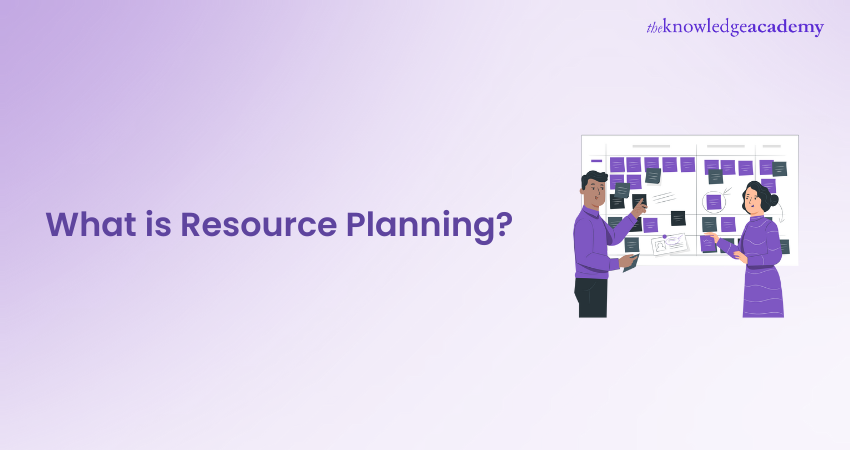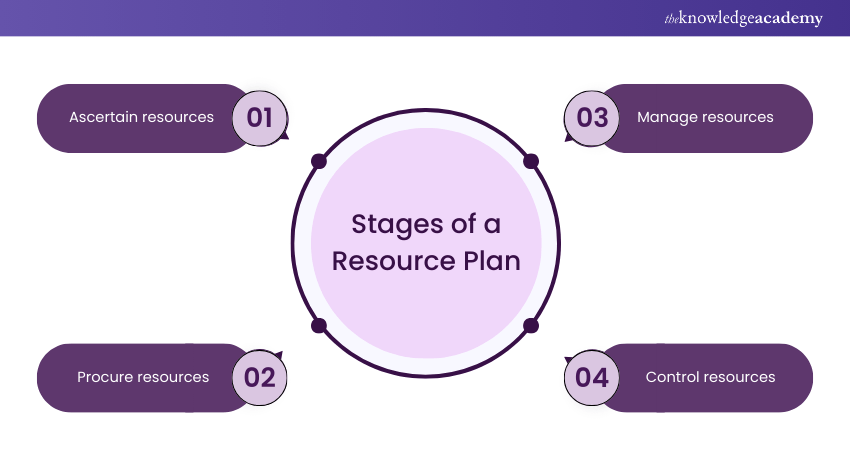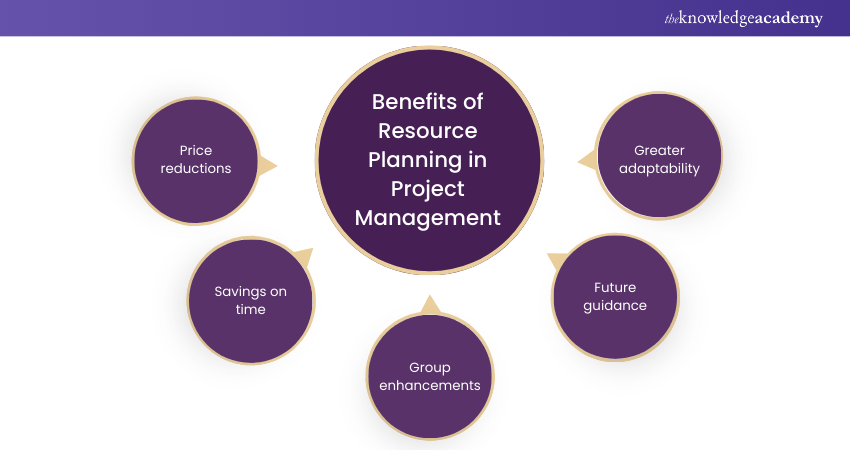We may not have the course you’re looking for. If you enquire or give us a call on 01344203999 and speak to our training experts, we may still be able to help with your training requirements.
Training Outcomes Within Your Budget!
We ensure quality, budget-alignment, and timely delivery by our expert instructors.

Have you ever wondered how Project Managers ensure their projects are completed on time, within budget, and with the desired outcomes? This is where Resource Planning steals the show. But What is Resource Planning, and how can it be used effectively?
Resource Planning is planning and managing the resources needed for a project. It is one of the key aspects of Project Management, as it determines the project's feasibility, scope, and schedule. This blog will explain What is Resource Planning, how it works, its key components, why it is important, and the stages of a Resource Plan.
Table of Contents
1) What Is Resource Planning?
2) Key components of Resource Planning template
3) Resource Planning's significance in project management
4) Stages of a Resource Plan
5) Benefits of Resource Planning in Project Management
6) Best practices for efficient Resource Planning
7) Conclusion
What is Resource Planning?
Resource Planning is determining and allocating the resources needed for a project. Resources are the inputs used to produce the project's outputs. They can be classified into three main categories:
a) Human resources: the people who work on the project, such as Project Managers, team members, stakeholders, contractors, etc.
b) Physical resources: resources include the materials, equipment, tools, facilities, and infrastructure used for the project, such as raw materials, machinery, vehicles, office space, etc.
c) Financial resources: the money spent or earned by the project, such as budget, expenses, revenue, etc.
Resource Planning involves identifying, estimating, acquiring, and monitoring the resources required for each task and phase of the project. It also involves managing resource availability, allocation, utilisation, and performance throughout the project lifecycle.
How Resource Planning Works?
Resource Planning works by following a systematic process that consists of four main steps:
a) Identify the resource requirements: It involves defining the project scope, objectives, deliverables, and activities and estimating the type, number, and duration of resources needed for each task.
b) Procure the resources: This involves acquiring resources not available internally, such as hiring, outsourcing, contracting external resources, or purchasing new tools or materials.
c) Allocate and schedule the resources: It involves assigning the resources to the tasks, creating a detailed resource schedule, and communicating the Resource Plan to the project team and stakeholders.
d) Monitor and control the resources: It involves measuring resource performance, comparing it with the planned resource baseline, and identifying and correcting variances or deviations. It also consists of evaluating resource outcomes, documenting the resource lessons learned, and providing feedback and recognition to resource providers.
Resource Planning is a vital part of Project Management that helps ensure the project's success. Following the four Resource Planning steps, the Project Manager can identify, organise, and allocate the project's resources and monitor and improve their performance and outcomes. Resource Planning requires careful planning, analysis, communication, coordination among the project team and stakeholders and various tools and techniques to optimise resource utilisation and efficiency.
Key components of Resource Planning template
Components of Resource Planning are the essential elements involved in the process of planning and managing a project's resources. They include:
a) Resource identification is the process of determining the quantities and types of resources required for each phase of the project based on the project scope, objectives, and deliverables.
b) Resource estimation estimates the time, effort, and cost required for each resource based on the project schedule, quality standards, and risk factors.
c) Resource acquisition is obtaining resources from internal or external sources, such as hiring, outsourcing, purchasing, leasing, etc.
d) Resource allocation is assigning and distributing resources to each task and phase of the project according to their availability, priority, and dependency.
e) Resource utilisation is using and consuming the project's resources according to capacity, efficiency, and performance.
f) Resource monitoring is tracking and controlling resource availability, allocation, utilisation, and performance using tools such as resource calendars, resource breakdown structures, resource histograms, etc.
g) Resource performance measures and evaluates resources' quality, productivity, and profitability using metrics such as resource variance, earned value, and index.
h) Resource Planning is critical for Project Managers, enabling them to plan, execute, and control their projects effectively and efficiently.
Resource Planning's significance in Project Management
Resource Planning is determining and allocating the resources needed for a project, such as people, materials, equipment, and money. It is important in Project Management because it affects the project’s success, efficiency, and quality. Some of the benefits of Resource Planning are:
a) It ensures the project has sufficient and suitable resources to meet its objectives and deliverables.
b) It optimises the use and allocation of resources, avoiding resource shortages, conflicts, and wastage.
c) It reduces the project’s costs and risks by minimising resource overruns, delays, and errors.
d) It improves the project’s quality and performance by enhancing resource productivity, quality, and profitability.
e) It increases the project’s stakeholder satisfaction by meeting or exceeding their expectations and requirements.
Stages of a Resource Plan
A Resource Plan outlines the Resource Planning process and results for a project. It describes the resources needed, allocated, and used for the project and how they are managed and monitored. A Resource Plan typically consists of four stages:

Ascertain resources
The first stage of a Resource Plan is ascertaining the resources needed for the project. This stage involves identifying the types and quantities of resources required for each task and phase based on the project scope, objectives, and deliverables. Some of the methods and tools that can be used for resource identification are:
a) Work Breakdown Structure (WBS): A hierarchical decomposition of the project into smaller and manageable units, such as deliverables, activities, tasks, etc.
b) Resource Breakdown Structure (RBS): A hierarchical classification of the resources needed for the project, such as human, physical, and financial resources.
c) Requirements analysis: A process of eliciting, analysing, and validating the needs and expectations of the project stakeholders, such as customers, users, sponsors, etc.
d) Expert judgment: A technique of using the knowledge and experience of experts, such as subject matter experts, consultants, mentors, etc., to provide guidance and advice on the project.
The output of this stage is a resource inventory, which is a list of all the resources that are available or needed for the project, including their types, quantities, sources, costs, etc.
For example, a content marketing campaign may require writers, editors, designers, web developers, social media managers, software, hardware, and internet access. The Project Manager can document the resource requirements using tools such as a Work Breakdown Structure (WBS) and a Resource Breakdown Structure (RBS).
Procure resources
The second stage of a Resource Plan is to procure the resources needed for the project. It involves obtaining resources from internal or external sources, such as hiring, outsourcing, purchasing, leasing, etc. Some of the methods and tools that can be used for resource acquisition are:
a) Make-or-buy analysis: A technique of comparing the costs and benefits of making or buying resources, such as in-house production, outsourcing, contracting, etc.
b) Market research: A technique of gathering and analysing information about the availability, quality, and price of the resources in the market, such as suppliers, vendors, competitors, etc.
c) Negotiation: A technique of reaching an agreement with resource providers, such as suppliers, vendors, contractors, etc., on the terms and conditions of the resource acquisition, such as scope, quality, schedule, cost, etc.
Contract management: A process of managing the contracts established with the resource providers, such as suppliers, vendors, contractors, etc., including their creation, execution, and closure.
The output of this stage is a resource allocation, a table or chart showing how the resources are assigned to each task and phase of the project, including their start and end dates, durations, dependencies, etc.
For example, a content marketing campaign may need to outsource some of the writing or design work to freelancers or agencies, and the Project Manager should ensure that they deliver high-quality work within the agreed deadlines and budget.
Manage resources
The third stage of a Resource Plan is managing the resources allocated for the project. It involves coordinating and directing the resources throughout the project lifecycle, ensuring they are used effectively and efficiently. Some of the methods and tools that can be used for resource management are:
a) Resource levelling: A technique of adjusting the start and end dates of the tasks to balance the demand and supply of the resources, avoiding resource overallocation or under allocation.
b) Resource smoothing: A technique of shifting the start and end dates of the tasks to reduce the fluctuations and variations in resource utilisation without affecting the project duration or scope.
c) Resource calendars: A tool that shows the availability and unavailability of resources, such as working hours, holidays, vacations, etc.
d) Resource histograms: A tool that shows the distribution and allocation of resources over time, such as resource demand, capacity, surplus, etc.
The output of this stage is resource utilisation, a graph or report showing how the resources are used and consumed by the project, including their availability, demand, capacity, efficiency, etc.
For example, a content marketing campaign may need to adjust the resource schedule based on the client's or management's feedback, revisions, and approvals.
Control resources
The fourth stage of a Resource Plan is controlling the resources used for the project. This stage involves monitoring and measuring the performance and progress of the resources and taking corrective actions if needed. Some of the methods and tools that can be used for resource control are:
a) Performance measurement: A technique of comparing the actual and planned performance of resources using metrics such as resource variance, resource earned value, resource index, etc.
b) Performance analysis: A technique of identifying the causes and effects of the deviations and discrepancies in the resource performance, using tools such as root cause analysis, fishbone diagram, Pareto chart, etc.
c) Performance improvement: A technique of implementing the changes and improvements in the resource performance using tools such as an action plan, change request, change log, etc.
d) Performance reporting: A technique for communicating the status and results of resource performance using tools such as a dashboard, scorecard, report, etc.
The output of this stage is a resource performance dashboard or scorecard that shows how the resources are performing and contributing to the project, including their quality, productivity, profitability, etc.
For example, a content marketing campaign may need to measure its impact on the target audience, website traffic, and sales conversions and use the results to improve future Resource Planning and execution.
Benefits of Resource Planning in Project Management
Resource Planning has many benefits for Project Management, as it helps to achieve the project's goals and objectives while ensuring the optimal use and management of the resources. Some of the benefits of Resource Planning are:

Price reductions
Resource Planning can reduce the project's costs by minimising resource overruns, delays, and errors. By estimating and acquiring the resources accurately and efficiently, Resource Planning can avoid unnecessary or excessive spending on them. Resource Planning can also avoid resource wastage, duplication, or under utilisation by allocating and utilising the resources effectively and efficiently. By monitoring and controlling the resources continuously and consistently, Resource Planning can avoid resource conflicts, risks, or issues.
Savings on time
Resource Planning can save the project time by optimising the project's schedule and duration. By promptly identifying and acquiring the resources, Resource Planning can avoid shortages, unavailability, or delays. By allocating and adequately levelling the resources, Resource Planning can avoid resource overallocation, under allocation, or imbalance. By monitoring and smoothing the resources regularly and periodically, Resource Planning can avoid resource fluctuations, variations, or disruptions.
Group enhancements
Resource Planning can enhance the project team by improving the team's collaboration and communication. By involving and engaging the team members in the Resource Planning process, Resource Planning can increase the team's commitment, ownership, and accountability. Resource Planning can increase the team's competence, performance, and productivity by assigning and directing the team members according to their skills, roles, and responsibilities. Resource Planning can increase the team's feedback, recognition, and reward by tracking and measuring the team members' progress and contribution.
Future guidance
Resource Planning can guide the project's future by providing valuable insights and lessons learned. By documenting and reviewing the Resource Planning process and results, Resource Planning can provide helpful information and data for future reference and analysis. By evaluating and assessing the Resource Planning performance and outcomes, Resource Planning can give meaningful feedback and recommendations for future improvement and enhancement. By updating and adjusting the Resource Planning according to the project's changes and needs, Resource Planning can provide flexible and adaptive solutions for future challenges and opportunities.
Greater adaptability
Resource Planning can increase the project's adaptability by enabling it to cope with uncertainty and change. By anticipating and preparing for resource needs and demands, Resource Planning can reduce the project's vulnerability and dependency. By estimating and acquiring resource contingencies and reserves, Resource Planning can increase the project's resilience and robustness. Resource Planning can increase the project's responsiveness and agility by monitoring and controlling resource changes and variations.
Best practices for efficient Resource Planning
Resource Planning is a complex and challenging process that requires careful planning and execution. To ensure efficient and effective Resource Planning, Project Managers should follow some best practices, such as:
a) Define the project scope, objectives, and deliverables clearly and precisely to determine the resource requirements and expectations.
b) Involve and engage the project stakeholders, such as customers, users, sponsors, team members, etc., in the Resource Planning to ensure their input, feedback, and approval.
c) Use appropriate methods and tools, such as WBS, RBS, requirements analysis, expert judgment, etc., to identify and estimate the resources accurately and realistically.
d) Use reliable sources and providers, such as suppliers, vendors, contractors, etc., to acquire the resources promptly and cost-effectively.
e) Use suitable techniques and software, such as resource levelling, resource smoothing, resource calendars, resource histograms, etc., to allocate and utilise the resources optimally and efficiently.
f) Use relevant metrics and indicators, such as resource variance, resource earned value, resource index, etc., to monitor and measure the resource performance and progress.
g) Use effective communication and reporting, such as dashboard, scorecard, report, etc., to inform and update the project stakeholders about the resource status and results.
h) Use continuous improvement and learning, such as performance analysis, performance improvement, performance reporting, etc., to enhance and refine the Resource Planning process and outcomes.
Plan your resources well with our course on Workforce Resource Planning Training. Join now!
Conclusion
Resource Planning is a crucial process that helps ensure any project's success. It involves identifying, allocating, and managing the resources needed for the project and ensuring that they are used optimally and efficiently. Resource Planning can bring many benefits to Project Management, such as price reductions, time savings, group enhancements, future guidance, and greater adaptability. Understanding Resource Planning and how it works can improve your project planning and execution skills and deliver better project outcomes.
Frequently Asked Questions

Resource Planning involves determining and allocating the resources needed for a project, while resource management involves coordinating and directing the resources throughout the project lifecycle.

Some of the challenges and risks of Resource Planning are:
Resource scarcity, resource uncertainty, resource complexity, resource conflict, resource change, etc. These challenges and risks can affect the project's scope, quality, schedule, cost, and stakeholder satisfaction.

The Knowledge Academy takes global learning to new heights, offering over 30,000 online courses across 490+ locations in 220 countries. This expansive reach ensures accessibility and convenience for learners worldwide.
Alongside our diverse Online Course Catalogue, encompassing 17 major categories, we go the extra mile by providing a plethora of free educational Online Resources like News updates, Blogs, videos, webinars, and interview questions. Tailoring learning experiences further, professionals can maximise value with customisable Course Bundles of TKA.

The Knowledge Academy’s Knowledge Pass, a prepaid voucher, adds another layer of flexibility, allowing course bookings over a 12-month period. Join us on a journey where education knows no bounds.

The Knowledge Academy offers various Management Courses, including the Introduction to Management Course, Workforce Resource Planning Training and Costing and Pricing Training. These courses cater to different skill levels, providing comprehensive insights into Project Resource Management.
Our Business Skills Blogs cover a range of topics related to Workforce Management, offering valuable resources, best practices, and industry insights. Whether you are a beginner or looking to advance your Management skills, The Knowledge Academy's diverse courses and informative blogs have got you covered.
Upcoming Business Skills Resources Batches & Dates
Date
 Workforce Resource Planning Training
Workforce Resource Planning Training
Fri 28th Feb 2025
Fri 4th Apr 2025
Fri 27th Jun 2025
Fri 29th Aug 2025
Fri 24th Oct 2025
Fri 5th Dec 2025







 Top Rated Course
Top Rated Course



 If you wish to make any changes to your course, please
If you wish to make any changes to your course, please


